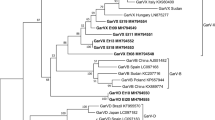Summary.
Degenerate primers for RT-PCR were designed and used to amplify genome fragments (c. 750 nt in the coat protein-ORF6 region) of allexiviruses from a total of 28 garlic samples from 24 provinces in China. Many samples contained more than one distinct sequence. A total of 60 different sequences were obtained. Phylogenetic analysis and two-way comparisons were used to assess the status of the sequences and to re-examine the criteria for distinguishing species within the genus. Most of the sequences could be allocated to either Garlic virus D or Garlic virus X on the basis of sequence similarity but some appeared to be intermediate between existing species. There were no sequences of Garlic virus C or Shallot virus X. A comparison with the related genera Carlavirus, Foveavirus and Potexvirus suggests that the published allexivirus species demarcation criteria may have been drawn too tightly and should be re-examined.
Similar content being viewed by others
Author information
Authors and Affiliations
Rights and permissions
About this article
Cite this article
Chen, J., Zheng, HY., Antoniw, J. et al. Detection and classification of allexiviruses from garlic in China. Arch Virol 149, 435–445 (2004). https://doi.org/10.1007/s00705-003-0234-2
Received:
Accepted:
Published:
Issue Date:
DOI: https://doi.org/10.1007/s00705-003-0234-2




